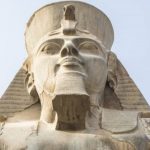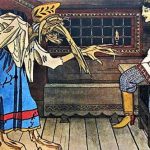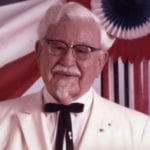 Mysteries
Mysteries  Mysteries
Mysteries  History
History 10 Surprising Stories About the Texas Rangers
 Humans
Humans 10 Philosophers Who Were Driven Mad by Their Own Theories
 Miscellaneous
Miscellaneous 10 Video-Game-Worthy Weapons and Armors from History
 Weird Stuff
Weird Stuff 10 Psychics Who Accurately Predicted Wartime Events
 The Arts
The Arts 10 Pieces of Art Inspired by a Broken Heart
 Health
Health 10 Science Fiction-Sounding New Medical Treatments
 History
History 10 Surprising Facts About the Father of Submarine Warfare
 Space
Space Ten Astonishing New Insights into Alien Worlds
 Weird Stuff
Weird Stuff 10 Bizarre Summer Solstice Rituals Still Practiced Today
 Mysteries
Mysteries Top 10 Haunting Facts About the Ghost Ship MV Alta
 History
History 10 Surprising Stories About the Texas Rangers
 Humans
Humans 10 Philosophers Who Were Driven Mad by Their Own Theories
Who's Behind Listverse?

Jamie Frater
Head Editor
Jamie founded Listverse due to an insatiable desire to share fascinating, obscure, and bizarre facts. He has been a guest speaker on numerous national radio and television stations and is a five time published author.
More About Us Miscellaneous
Miscellaneous 10 Video-Game-Worthy Weapons and Armors from History
 Weird Stuff
Weird Stuff 10 Psychics Who Accurately Predicted Wartime Events
 The Arts
The Arts 10 Pieces of Art Inspired by a Broken Heart
 Health
Health 10 Science Fiction-Sounding New Medical Treatments
 History
History 10 Surprising Facts About the Father of Submarine Warfare
 Space
Space Ten Astonishing New Insights into Alien Worlds
 Weird Stuff
Weird Stuff 10 Bizarre Summer Solstice Rituals Still Practiced Today
Ten Famous and (Sometimes) Strange Musical Alter Egos
Musicians love alter egos, and pop music is full of them. They serve a range of functions, from making the music tell a story to providing a flamboyant persona unencumbered by stage fright for an otherwise shy performer to embody. Some of the best music explores notions of identity, which is why some artists just can’t resist adopting one. So sit back and tune in as we list 10 musical alter egos!
Related: Top 10 Musicians Who Were Ahead Of Their Time
10 Kiss
As always with these lists, there’s plenty of room to quibble about what an alter ego is. One could argue that any musician who uses a stage name, writes songs from the point of view of a character, or just says, “I’m a different person when I’m on stage,” is using an alter ego. Similarly, you may argue that a bit of grease paint does not an alter ego make.
But—iconic as their makeup may be—the sheer base ridiculousness that is Kiss’s onstage personas could not possibly constitute anything as conceptually lofty as an alter ego. Sure, each member of the group has a distinct character, and those characters even have names, but it’s still just a stage costume. I’d be inclined to agree if it weren’t for the fact that for almost twenty years now, Kiss has been openly discussing the prospect of the band continuing with none of its original members.
The idea may sound like defeatist talk from geriatric rockers whose ability to command a stage and belt out the hits is waning. Still, back in 2005, when the idea was first mooted, Gene Simmons and Paul Stanley were only in their 50s. For comparison, Mick Jagger was 79 when The Rolling Stones wrapped up their most recent tour.
Could perhaps The Demon, The Dame, The Starchild, and The Catman personas be bigger than Gene Simmons, Paul Stanley… and the other two?
The other two were originally Ace Frehley (The Starchild) and Peter Criss (The Catman). In the early ’80s, when Frehley and Criss were ousted from the band, their replacements—Eric Carr and Vinnie Vincent—were given their own alter egos, the Fox and the Ankh Warrior (sometimes known as The Egyptian Warrior, simply The Warrior, or The Wiz for some reason). However, the current “other two” (Eric Singer and Tommy Thayer) have adopted the classic Starchild and Catman personas—setting Kiss up as a concept in and of itself with a stable set of characters played by an ever-changing troupe of actors.
Then add in the decades-long media series that cast Kiss as superheroes, including a comic book and the 1978 movie Kiss Meets the Phantom of the Park. Or the time Kiss teamed up with Scooby-Doo, and it only reinforces the idea that we’re talking about creations much bigger than four mortal men. [1]
9 Chick (Mariah Carey)
This story is as simple as it is strange. In 1995, Mariah Carey wanted to make an alternative rock/punk album inspired by bands like Hole, Garbage, and Sleater-Kinney. And that’s exactly what she did; Someone’s Ugly Daughter was recorded secretly during the sessions for her fifth album Daydream. Her plan was to release it under a pseudonym, certain the world would eventually work out she was behind it.
However, Sony Music replaced her vocals with another singer, suppressed any connection to Carey, and released it under a smaller subsidiary. They even changed the name of the “band” that Someone’s Ugly Daughter was credited to from Eel Tree to Chick, an uninspired ad man’s idea of what a riot-grrrl band might be called. It sold 550 copies.
Someone’s Ugly Daughter remained forgotten for 25 years until Carey revealed its existence in her 2020 memoir The Meaning of Mariah Carey. She didn’t name the project, but her online fan club, the Lambily (because, of course), tracked it down, and soon enough, copies were going for $800 on Amazon.
As much as it saddens me to say, I think Sony’s shenanigans were for the best. 1995 just wasn’t ready for a Mariah Carey alternative rock album. With lyrics like “I’m locked inside a closet, dripping like a faucet, twisted like a sausage,” Someone’s Ugly Daughter reads like a parody of ’90s alt-rock. Nowadays, we’d read it for what it is, a goofy, loving parody. A self-parody as well because she clearly related to the genre. But 1995 would’ve read Someone’s Ugly Daughter as a mocking salvo from an upstart diva in the interminable rock vs. pop authenticity wars.
Those Internet sleuths who uncovered the truth behind Someone’s Ugly Daughter also noted that the videos contained oblique Mariah Carey references, such as butterfly tattoos and a cameo by her dog, that would’ve been understood by those familiar with the MCU (Mariah Carey Universe).[2]
8 Chris Gaines (Garth Brooks)
Speaking of ’90s alt-rock alter ego projects by the least likely people you could imagine…
The irony of country music’s obsession with authenticity is that the concept of authenticity is so nebulous it’s basically meaningless. One person’s good old-fashioned true country music is another person’s modern pop-crossover pap. So it’s not surprising that Garth Brooks, the most bankable country music star of the ’90s, was either authentic country’s savior or its ruin, depending on who you spoke to.
While many country stars before and since have embodied that duality, none have done so with quite the same intensity. In a genre that conflates crossover success with inauthenticity, Brooks’s status as the number-one-selling solo artist in U.S. history (ahead of Elvis!) was bound to encourage detractors, especially as Garth Brooks gave his football stadium-sized audiences exactly what they wanted, a football stadium-sized rock show.
Meanwhile, his aw-shucks schmaltz and dusty cowboy hat and boots image placed him comfortably in the country scene. Given that this “son of the south” image was his strongest link to the country music scene, it remains one of the music world’s most enduring mysteries why he would change personas to… Chris Gaines, an Australian emo alt-rocker.
Gaines’s look was a Halloween costume seemingly based on Goo Goo Dolls frontman Johnny Rzeznik, with shades of Elliot Smith thrown in. But it may also have been based on fellow country music star Keith Urban (which would explain the decision to make Gaines Australian, although Urban is from New Zealand, not Australia).
The plan was for Gaines to star in a movie called The Lamb. The movie never materialized; however, Gaines was still the subject of a VH1 Behind the Music mockumentary, which told his comically tragic, fictitious backstory, including a near-fatal sex addiction (!?), his battle against a forest fire armed only with a garden hose, and the time he drove his car off a cliff, necessitating full facial reconstruction surgery.
Chris Gaines’s body of work was limited to an appearance on Saturday Night Live and a single album, The Life of Chris Gaines. Confusingly, the album was released as Chris Gaines’ Greatest Hits in some markets, but then, almost every aspect of the short-lived Chris Gaines saga is confusing. I dare say those who lived through it have their doubts that it really happened.[3]
7 Ruben and the Jets (Frank Zappa and the Mothers of Invention)
“Frank Zappa Fan Thinks You Just Haven’t Heard The Right Album,” declared The Onion back in 2004. With a discography running to 62 studio albums in his lifetime, an equal number of posthumous albums, and a style that fuses proto-punk psychedelia, stately jazz-fusion instrumentals, and novelty comedy tracks, Frank Zappa’s work is utterly impenetrable by all but the most dedicated fans. There may very well be a “right” Frank Zappa to get non-fans hooked, but good luck finding it.
Cruising with Ruben and the Jets and its singles, however, achieved some radio success before it was revealed to be the work of Frank Zappa and the Mothers of Invention. The project was a tribute to ’50s rock ‘n roll and Chicano doo-wop, and therefore may just well be straightforward enough to be the “right” Frank Zappa album. Even if it was an installment in a series of albums with such titles as Lumpy Gravy, We’re Only In It for the Money, and Uncle Meat.
As time went on, Cruising with Ruben and the Jets’ legacy took a turn for the even stranger. Frank Zappa held a listening party at his Laurel Canyon home where he floated the idea of launching Ruben and the Jets as a real band; all he needed was a Chicano doo-wop singer with the first name Ruben. Incredibly, the search for such a person was a short one.
Prolific performance artist, sculptor, and activist Rubén Guevara Jr. lived a previous life fronting the doo-wop group The Apollo Brothers. Thus, under Guevara’s leadership, the fake band invented as “a last-ditch attempt [by Frank Zappa] to get [his] cruddy music on the radio” became a real band that made two more albums, with Zappa only behind the boards for the first.
Sidenote: Rubén Guevara Jr later developed his own alter ego. In 1990, he adopted the middle name Funkahuatl, a persona born of his experimental theatre works. Funkahuatl is the neo-Chicano Aztec god of funk.[4]
6 Sasha Fierce (Beyoncé)
Which iconic superstar shot to fame through the use of an alter ego, only to unceremoniously kill off said alter ego when they outgrew it? While David Bowie did it first with Ziggy Stardust, this isn’t that story. However, keep Ziggy Stardust in mind because the parallels between the alien rock messiah and Beyoncé’s Sasha Fierce are illuminating and help us understand both.
Ziggy and Sasha were both born of the necessity to perform songs with an energy to which their creators could not personally relate. Bowie wrote early songs as stories that needed a particular character to tell them, so he became that character to aid the narrative—an energy the man David Jones could not generate.
Beyoncé created Sasha Fierce as the free and sexy stage presence her songs needed since she herself was apparently shy. Sasha Fierce was B’s secret weapon right up until Beyonce lifted the veil and told the world about her on her third album. I A…Sasha Fierce is a double album, in which the first disc represents the true Beyoncé and the second is devoted to Sasha and her sexy, extroverted bangers such as “Single Ladies” and “Diva.”
These two alter egos are similar in that they were born of a need to protect or obfuscate the true persona beneath, but the differences between Ziggy and Sasha are interesting reflections of the different societies and privilege strata in which they were presented. Both were killed when their creators became comfortable singing as themselves, yet when Bowie killed off Ziggy, it was simply a restless man moving on; but when Sasha Fierce had outlived her usefulness, her death was a thing of such poignancy that it shifted the conversations around race and gender in pop music.
In 2013, Beyoncé stated plainly to Allure magazine that she’d “killed” Sasha Fierce because she had grown and was now able to “merge” with Sasha. B’s 2013 self-titled “visual album” was an almost violent repudiation of the dated Freudian binary that Sasha Fierce represented. The Washington Post described the album as “an exploration of gender and power and an unwavering look at black female sexual agency.” The Beyoncé of 2013 and Beyonce today does not need to distance herself from her sexuality with an alter ego, which forces us to confront the fact that disembodying her sexuality into an alter ego was her way of navigating a society that demands sexiness from women, all while punishing and suppressing their sexuality.[5]
5 David Bowie (More Than Just Ziggy)
For all there is to say about Ziggy Stardust, Bowie’s most famous alter ego, most of it amounts to little more than headcanon. Bowie said himself that “Ziggy, for me, was a very simplistic thing. What it seemed to be was an alien rock star, and for performance value, I dressed as him and acted him out—I left it at that. Other people reread him and contributed more information about Ziggy than I put into him.”
Ziggy’s story, well documented as it is, is mostly the creation of fans, with all the vagaries and contradictions that they imply (for instance, see the fan debates over whether or not Aladdin Sane is a separate, distinct character from Ziggy). And then there are the alter egos that fans may well have created out of whole cloth, such as Major Tom and Halloween Jack. Sure, these were characters in his songs, but those songs refer to them in the third person. Whether they were Bowie or Bowie was them is something we may never know.
Ziggy is so famous he overshadows an almost forgotten coterie of Bowie alter egos who deserve more attention. In 1995, Bowie went off the deep end to end all deep ends with the 75-minute concept album Outside, subtitled The Diary of Nathan Adler or the Art-Ritual Murder of Baby Grace Blue—A Non-Linear Gothic Drama Hyper-Cycle.
Outside takes place in a futuristic dystopia and features characters such as the sub-titular Nathan Adler, a hardened gumshoe with a Chicago accent that only a native Londoner could conjure, and Baby Grace Blue, the 14-year-old girl at the center of the mystery. There is also Ramona A. Stone, an evil, haughty, green-skinned art critic who dreams of “ape men with metal parts,” and Algeria Touchshriek, a mysterious junk shop owner and self-described “broken man” and “reject from the world wide internet” (how one can be rejected from the Internet would be very useful information right now). And yes, they are all alter egos, as Bowie plays them all, even the teenage girl, in spoken-word interludes peppered throughout.
Then there’s Bowie’s final alter ego, the rarely mentioned Blind Prophet. The videos for Bowie’s final two singles (the latter of which was famously released two days before his death) both feature Bowie blindfolded with buttons over his eyes. We’ll never know what the Blind Prophet saw as Bowie took that knowledge with him when he left us. Stories without denouements are like itches we can’t scratch—just another way his legacy is felt.[6]
4 Roman Zolandski (Nicki Minaj)
“First thing’s first, I’ll eat your brains…”
When Nicki Minaj appeared on Kanye West’s posse track “Monster,” she’d released just two singles, neither of which were successful in any way. Her debut album was two months away. But her verse on “Monster” set the world on fire. Without her, “Monster” would’ve plodded along as a series of disjointed guest verses, but when Minaj comes in about two-thirds of the way through, “Monster” becomes a Nicki Minaj song…
Except for the fact that if you weren’t familiar with her, you might think you were listening to two rappers trading bars as her voice flits effortlessly between a violently camp growl and a hyperfeminine lilt. We’d learn later that the growl belonged to Roman Zolandski, a gay man from London with a British Afro-Caribbean accent half the time, and sounds like Ludacris impersonating Dick van Dyke in Mary Poppins the other half.
Nicki describes Roman as living inside her and saying the things she does not want to say, which makes him sound like a Sasha Fierce. But Nicki Minaj is not exactly a shrinking violet without him. Still, he and Nicki are inextricably linked; she also said that she’s asked him to leave, but he can’t. In 2014, Nicki Minaj declared that she was bored with him and that he died.
However, he returned a year later to participate in a developing beef with Miley Cyrus. Interestingly, Nicki Minaj does not change her appearance to play Roman, except for color themes and gestures that fans understand signify Roman; this further supports the view that he’s a presence inside her who emerges when needed.
His story has been retconned a little bit too. Nicki Minaj first described him as being “conspicuously female” but became canonically male shortly afterward. As well as changing gender, he’s also gone from being a violently angry id to a playful mischiefmaker. He has also gone from a Moscow borstal to an interdimensional fantasy battle battleground called the PinkSpace.
My personal theory is that he was once a tool that allowed a conflicted artist to be explicit and uninhibited, but when he was no longer needed, instead of killing him off, she rolled him into an ever-expanding cast of alter egos (which now includes Roman’s mother, Martha). One day, we’ll discover the Rosetta Stone for understanding Nicki Minaj; until then, all we can do is enjoy the ride.[7]
3 Orville Peck (Daniel Pitout)
Future generations of country music fans will look back at the history of the genre as having two eras, before Lil Nas X and after Lil Nas X. Before Lil Nas X, country stars could be booted from the genre simply for not looking the part. But after, Nas, a black, gay, teenage Soundcloud rapper, just missed out on topping the Billboard country charts due to a widely panned attempt by Billboard to hold back the tide of progress; accepting a gay, South African country star hailing from the worlds of queercore punk and West End musical theater was not such a stretch. Lil Nas X walked so that Orville Peck could run.
Orville Peck is the alter ego of Daniel Pitout from the Canadian punk band Nü Sensae, and while alter egos have been one of the few constants of the music industry, I cannot think of any others quite like Orville Peck. Peck is a constructed persona that, rather than creating a wall of artifice between the artist and their music, brings them together and brings us, the audience, closer too. Orville Peck is a contradiction—a lie that reveals the truth.
Peck’s songs are remarkably earnest and conventional, just three chords and the truth. His music does not befit a Lil Nas X-type debate over whether or not it’s “real” country. A more conventional strategy for avoiding such a debate may have been to create a southern-fried yee-hawing heterosexual alter ego. Still, Orville Peck has the exact same biography as Daniel Pitout: queerness, exotic origin, and all.
Orville Peck exposed that those authenticity debates are less debates than they are personal attacks, and attacks require a target. The bigots who would laugh at the gay cowboy just don’t find any satisfaction in it if they don’t know who the gay cowboy is. By depriving the naysayers of a target, Orville Peck can be more or less himself. In fact, his second album, Bronco, which came out after his identity was revealed, was markedly more slick and impersonal than his debut, released when his identity was still a mystery.[8]
2 Billy Shears (Ringo Starr)
Although there’s a consensus that The Beatles’ Sgt. Pepper’s Lonely Hearts Club Band is the world’s first concept album, the concept of a concept album is pretty… well, fuzzy. So though we all agree that Sgt. Pepper’s is a concept album, we can’t all agree on what a concept album is. Some say that a concept album is one in which there are recurring themes across the songs, constituting an overarching concept. But by that definition, almost all albums that followed Sgt. Pepper’s are concept albums, as are several that came before it too. An album that is just a collection of songs with no connective tissue would be the exception these days.
While others maintain that a concept album tells a story. Though this interpretation is fuzzy by necessity, as music is just not the medium for coherent storytelling. An album that told a story would require a significant amount of interpretation. (There could be concept albums out there that we don’t know about because no one has interpreted the story correctly.)
If Sgt. Pepper’s is the latter, then only the first two songs (and reprise) support a clear narrative arc (John Lennon himself confirmed that the concept, beyond those two songs, is basically a confidence trick). The stomping title track features Paul McCartney as an MC introducing the titular band’s enigmatic lead singer Billy Shears, as Ringo takes up vocal duties on what became his signature song, “With a Little Help from My Friends.”
Over the past sixty-plus years, every question that could possibly be asked about the Beatles has been asked. So we must assume that the unanswered questions simply do not have answers. Sgt. Pepper has been examined and dissected extensively. Yet, we know very little about the story of Billy Shears and his band beyond what’s in the lyrics.
A Broadway stage musical and a movie have both tried to flesh out the story, but these were unauthorized by the fab four. Though perhaps the most compelling theory is that it’s another arcane confession that Paul McCartney had died and been replaced with a lookalike. The lookalike: an Edinburgh orphan named William Shears Campbell.[9]
1 Slim Shady (Eminem)
It’s often said that Slim Shady is Em’s crass, violent id, as if giving his puerile anger a name allowed him the freedom to express it. But like with Nikki Minaj’s Roman Zolanski, I find it hard to imagine that Eminem would’ve ever held anything back, with or without Slim. Still, from looking at Slim Shady’s dramatic introduction to the world on 1997’s Slim Shady EP, it’s clear that Slim was borne from necessity, a Hail Mary from a young man in a pretty desperate situation.
Eminem’s debut album Infinity, released a year before, had sold somewhere between 70 and a few hundred copies, depending on who you ask. Before Infinity, Eminem was working 60-hour weeks at a minimum-wage job to support his young daughter in a home that was robbed several times.
After Infinity, he was fired from his job and was raising his daughter in his mother’s mobile home. The Slim Shady EP begins with Slim shaking Eminem awake and forcing him to look in the mirror and confront himself. The Slim Shady persona may be violently evil, but he was a force for good in Eminem’s life. It’s hard to imagine an artist who owes their career to an alter ego more than Eminem.
The Slim Shady EP was a precursor to The Slim Shady LP, which was the last album he recorded as a non-millionaire, and the last Eminem album not to hit number 1 on the Billboard charts. The LP made Eminem an overnight celebrity and household name. Eminem played off that meteoric rise to fame as a double-edged sword, complaining in tracks such as “The Way I Am” and “Stan” about not just the pressures of fame but also the pressures of being a controversial figure linked to all manner of societal issues.
Memorably, “Stan” is about a crazed fan who commits a murder-suicide when his fan letters are not returned. The moment when Em realizes he’s been put on that life and death pedestal, a position that he neither asked for nor is qualified for, is about as real as pop music gets. But his complaints have an air of humblebrag about them too. “I’ve created a monster ’cause no one wants to see Marshall no more. They want Shady, I’m chopped liver.”
It wasn’t just fame that Slim Shady gave Eminem; Eminem was in awe of the power Slim Shady had to make him the most controversial person in the world, a person ascribed with life and death power over a legion of young fans.[10]
+ Bonus Track: @onionringsworldwide (Lorde)
@onionringsworldwide may not be a musical alter ego, but the fact that it was a secret persona that allowed an extremely famous person to act with freedom and anonymity means it very much belongs on this list. While other alter egos allow their creators the freedom to experiment with different genres or expose different elements of their psyches, @onionringsworldwide allowed Lorde the greatest freedom of all—the freedom to eat lots of onion rings and have really, really ridiculously complex opinions about them.
@onionringsworldwide was a mysterious Instagram account solely devoted to reviewing onion rings. The account was discovered in 2017 by an anonymous fan, who noticed that it followed no one and was followed only by Lorde and her associates. The fan passed the scoop on to a journalist at Newshub, who did the kind of investigative reporting that has not been seen since the days of Upton Sinclair to prove that Lorde was behind the account. The account went inactive soon afterward, and Lorde was forced to confirm that she was, in fact, the one behind the account.
We have known since 1996 that it’s dangerous for any famous musician to become associated with a food product. The Foo Fighters retired their hit “Big Me” due to fans pelting the band with Mentos when they played it—the video was a parody of the Mentos ads, you see. Perhaps not wanting to be pelted with onion rings on stage was her reason for keeping @onionringsworldwide a secret… Although Lorde does seem to be really, really into onion rings.[11]
@onionringsworldwide returned in 2021… However, this author cannot confirm whether or not the account is still active, as I cannot make heads or tails of Instagram.








